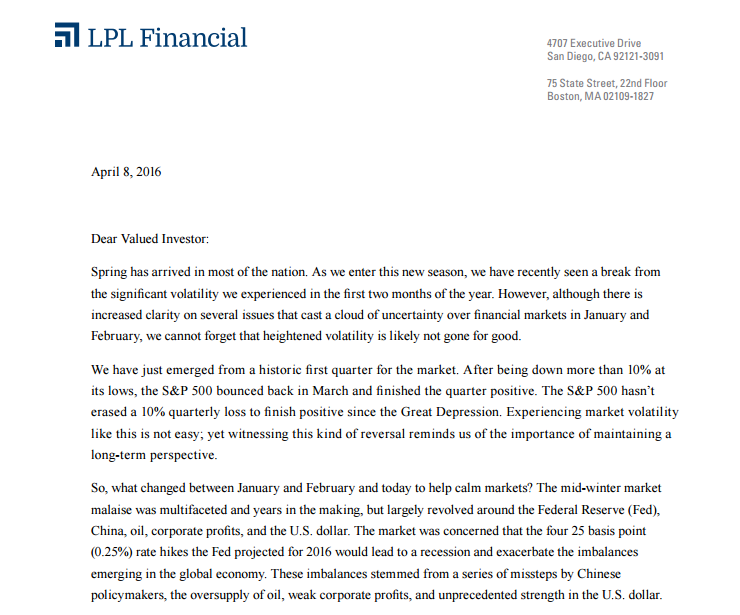Dear Valued Investor:
Spring has arrived in most of the nation. As we enter this new season, we have recently seen a break from the significant volatility we experienced in the first two months of the year. However, although there is increased clarity on several issues that cast a cloud of uncertainty over financial markets in January and February, we cannot forget that heightened volatility is likely not gone for good.
We have just emerged from a historic first quarter for the market. After being down more than 10% at its lows, the S&P 500 bounced back in March and finished the quarter positive. The S&P 500 hasn’t erased a 10% quarterly loss to finish positive since the Great Depression. Experiencing market volatility like this is not easy; yet witnessing this kind of reversal reminds us of the importance of maintaining a long-term perspective.
So, what changed between January and February and today to help calm markets? The mid-winter market malaise was multifaceted and years in the making, but largely revolved around the Federal Reserve (Fed), China, oil, corporate profits, and the U.S. dollar. The market was concerned that the four 25 basis point (0.25%) rate hikes the Fed projected for 2016 would lead to a recession and exacerbate the imbalances emerging in the global economy. These imbalances stemmed from a series of missteps by Chinese policymakers, the oversupply of oil, weak corporate profits, and unprecedented strength in the U.S. dollar.
In the past couple of months, many of these issues have started to resolve. At its March policy meeting, the Fed changed its tune slightly from the December 2015 meeting and reduced its forecast for rate hikes this year from four to just two, citing concerns around global imbalances and economic growth. This more market-friendly projection helped to push the dollar lower and oil higher, alleviating some stress in global financial markets (though oil was already benefiting from supply cuts and speculation of an OPEC production freeze). Meanwhile, China, which said or did all the wrong things managing its currency, economy, and financial markets during the second half of 2015 and again in early 2016, has mostly turned that around recently. The weaker dollar, soothing words from China, and the rebound in oil prices helped to renew a slightly more positive corporate profit outlook and sparked an impressive market rebound.
After the market dips, reversals, and dramatic shifts in investor sentiment, what can we expect as we look ahead? In our view, the second quarter of 2016—and the rest of the year—may look a lot like the first quarter, as many of the areas of concern we faced—Fed rate hikes, oil prices, earnings declines—remain in the background.
Although we foresee a continuation of this heightened volatility throughout the rest of 2016, we continue to expect stocks to deliver mid-single-digit returns in 2016 as the U.S. economic expansion continues.* And through this, we emphasize the importance of maintaining a long-term perspective and staying committed to a well-formulated investment plan.
As always, if you have questions, I encourage you to contact your financial advisor.
Sincerely,
John Canally, CFA
SVP, Chief Economic Strategist
LPL Research
Click here to download a PDF of this report.
*Historically since WWII, the average annual gain on stocks has been 7–9%. Thus, our forecast is roughly in-line with average stock market growth. We forecast a mid-single-digit gain, including dividends, for U.S. stocks in 2016 as measured by the S&P 500. This gain is derived from earnings per share (EPS) for S&P 500 companies assuming mid- to high-single-digit earnings gains, and a largely stable price-to-earnings ratio (PE). Earnings gains are supported by our expectation of improved global economic growth and stable profit margins in 2016.
The opinions voiced in this material are for general information only and are not intended to provide specific advice or recommendations for any individual security. To determine which investment(s) may be appropriate for you, consult your financial advisor prior to investing. All performance referenced is historical and is no guarantee of future results. Indexes are unmanaged and cannot be invested into directly.
Economic forecasts set forth may not develop as predicted.
Investing in stock includes numerous specific risks including: the fluctuation of dividend, loss of principal and potential illiquidity of the investment in a falling market.
The S&P 500 Index is a capitalization-weighted index of 500 stocks designed to measure performance of the broad domestic economy through changes in the aggregate market value of 500 stocks representing all major industries.
This research material has been prepared by LPL Financial LLC.
To the extent you are receiving investment advice from a separately registered independent investment advisor, please note that LPL Financial LLC is not an affiliate of and makes no representation with respect to such entity.
Not FDIC/NCUA Insured | Not Bank/Credit Union Guaranteed | May Lose Value Not Guaranteed by Any Government Agency | Not a Bank/Credit Union Deposit
Tracking #1-485908 (Exp. 04/17)
